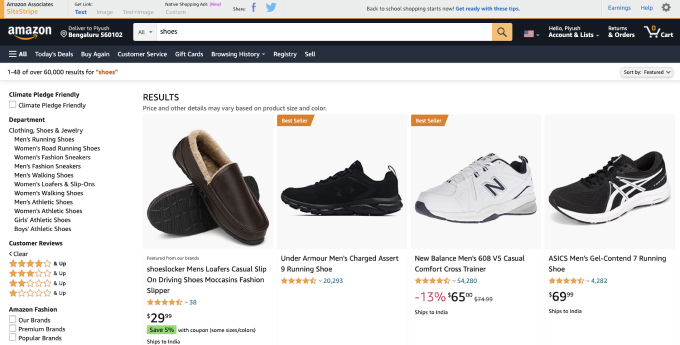Why Selling Shoes Can Be a Lucrative Venture
The demand for second-hand shoes has been on the rise in recent years, driven by consumers looking for sustainable and affordable fashion options. As a result, selling shoes can be a lucrative venture for those looking to declutter their closets and make some extra money. With the rise of online marketplaces and social media platforms, it’s easier than ever to connect with potential buyers and sell your unwanted shoes. Whether you’re looking to get rid of a few pairs of gently used shoes or you’re a serious sneakerhead with a collection to sell, there are many platforms available to help you turn your old kicks into cash.
One of the main benefits of selling shoes is the opportunity to declutter your closet and make some extra money. With the average American owning around 12 pairs of shoes, it’s likely that you have a few pairs that you no longer wear or need. By selling these shoes, you can free up space in your closet and earn some extra cash to put towards new shoes or other expenses. Additionally, selling shoes can be a great way to make some extra money on the side, whether you’re a student looking to supplement your income or a stay-at-home parent looking to earn some extra cash.
So, where can you sell shoes for money? The options are numerous, ranging from online marketplaces like eBay and Craigslist to social media platforms like Facebook Marketplace and Instagram. Specialized platforms like StockX and GOAT also cater to sneaker enthusiasts looking to buy and sell rare and limited-edition shoes. With so many options available, it’s easier than ever to find a buyer for your unwanted shoes and turn them into cash.
In fact, selling shoes can be a lucrative venture, with some rare and limited-edition shoes selling for thousands of dollars. For example, a pair of Nike Air Yeezy 1 “Prototype” sneakers sold for $104,000 on StockX in 2020. While not all shoes will sell for such high prices, it’s clear that there is a demand for second-hand shoes and that selling them can be a profitable venture.
How to Determine the Value of Your Shoes
Determining the value of your shoes is a crucial step in selling them for profit. The value of shoes can vary greatly depending on several factors, including condition, rarity, and brand. To determine the value of your shoes, you need to research and understand the market demand for similar shoes.
Condition is a significant factor in determining the value of shoes. Shoes that are in excellent condition, with minimal wear and tear, can command a higher price than those that are worn out or damaged. Rarity is another factor that can impact the value of shoes. Limited-edition shoes or those that are no longer in production can be highly valuable due to their scarcity.
Brand is also an essential factor in determining the value of shoes. Certain brands, such as Nike, Adidas, and Vans, are highly sought after and can command a premium price. Additionally, the popularity of the shoe model, the materials used, and the overall design can also impact the value of the shoes.
To research the value of your shoes, you can start by checking online marketplaces such as eBay, Craigslist, and Facebook Marketplace. Look for similar shoes that have sold recently and take note of their prices. You can also check specialized platforms like StockX and GOAT, which cater to sneaker enthusiasts and provide a wealth of information on shoe values.
Another way to determine the value of your shoes is to use pricing guides and apps. There are several apps available that can help you determine the value of your shoes, such as Sneaker News and Sole Collector. These apps provide pricing information and can help you stay up-to-date on the latest market trends.
When pricing your shoes, it’s essential to be competitive. Research your competition and price your shoes accordingly. Keep in mind that you want to make a profit, but you also want to attract buyers. If your prices are too high, you may deter potential buyers.
By understanding the factors that affect the value of shoes and researching the market demand, you can determine the value of your shoes and price them competitively. This will help you sell your shoes for profit and achieve your goals.
Popular Platforms for Selling Shoes
When it comes to selling shoes, there are numerous platforms to choose from, each with its own unique features and benefits. Online marketplaces, consignment shops, and social media platforms are just a few options available to sellers. In this section, we’ll explore some of the most popular platforms for selling shoes and provide tips on how to get the most out of each one.
eBay is one of the most popular online marketplaces for buying and selling shoes. With over 183 million active users, eBay provides a vast audience for sellers to showcase their shoes. To get started on eBay, simply create an account, take high-quality photos of your shoes, and write a detailed description of the item. You can also set a competitive price for your shoes by researching similar items that have sold on the platform.
Craigslist is another popular platform for selling shoes, with a large user base and a wide range of categories to choose from. When selling on Craigslist, be sure to include clear photos and a detailed description of the shoes, as well as a competitive price. You can also use Craigslist’s built-in messaging system to communicate with potential buyers.
Facebook Marketplace is a great platform for selling shoes, especially if you have a large network of friends and family. Simply take a photo of your shoes, write a brief description, and set a price. You can also join local buying and selling groups on Facebook to reach a wider audience.
Specialized platforms like StockX and GOAT are also great options for selling shoes, especially if you have rare or limited-edition items. These platforms cater to sneaker enthusiasts and provide a wealth of information on shoe values and market trends. To get started on StockX or GOAT, simply create an account, take high-quality photos of your shoes, and write a detailed description of the item.
In addition to online marketplaces and social media platforms, consignment shops are also a great option for selling shoes. Consignment shops will take a commission on the sale of your shoes, but they can also provide a wider audience and more competitive pricing. When choosing a consignment shop, be sure to research their fees and policies beforehand.
When selling shoes on any platform, be sure to follow the guidelines and rules set forth by the platform. This will help ensure a smooth and successful transaction, and will also help you build a positive reputation as a seller.
Tips for Taking High-Quality Photos and Writing Compelling Descriptions
When selling shoes online, high-quality photos and compelling descriptions are crucial in showcasing the condition and features of your shoes. In this section, we’ll provide tips on how to take clear, well-lit photos of your shoes from different angles, and how to write detailed, honest descriptions that will attract potential buyers.
When taking photos of your shoes, make sure to use good lighting. Natural light is always the best option, so try to take photos near a window or outside. Avoid using flash as it can create harsh shadows and unflattering light. Use a clean and simple background to make your shoes stand out. A white or light-colored background is usually the best option.
Take photos of your shoes from different angles, including the front, back, and sides. This will give potential buyers a clear view of the condition and features of your shoes. Make sure to include photos of any defects or flaws, such as scuffs or stains. This will help build trust with potential buyers and avoid any disputes down the line.
When writing descriptions of your shoes, be honest and detailed. Include information about the condition, size, and material of your shoes. Mention any defects or flaws, and provide photos to back up your claims. Use keywords that buyers might use when searching for shoes like yours, such as “Nike Air Jordan” or “limited edition sneakers”.
Use a clear and concise writing style, and avoid using jargon or technical terms that might confuse potential buyers. Make sure to include information about the shoes’ history, such as whether they have been worn or are brand new. Provide information about the shoes’ authenticity, such as whether they come with original packaging or documentation.
By taking high-quality photos and writing compelling descriptions, you can showcase your shoes in the best possible light and attract potential buyers. Remember to be honest and detailed in your descriptions, and use keywords that buyers might use when searching for shoes like yours.
In addition to photos and descriptions, consider adding additional information to your listing, such as the shoes’ measurements or the materials used in their construction. This will provide potential buyers with a more complete understanding of the shoes and help them make an informed decision.
How to Set Competitive Prices and Negotiate with Buyers
When selling shoes online, pricing is a crucial aspect to consider. You want to set a price that is competitive with other sellers, yet still allows you to make a profit. In this section, we’ll discuss the importance of pricing your shoes competitively and provide tips on how to negotiate with potential buyers.
To determine a competitive price for your shoes, research similar items that have sold on online marketplaces like eBay, Craigslist, and Facebook Marketplace. Look at the prices of shoes that are in similar condition, have similar features, and are from the same brand. You can also use pricing guides and apps to help you determine a fair price for your shoes.
When setting a price for your shoes, consider the costs of shipping, packaging, and any fees associated with the platform you’re using. You’ll also want to factor in the time and effort you put into taking photos, writing descriptions, and responding to inquiries.
Once you’ve set a price for your shoes, be prepared to negotiate with potential buyers. Respond promptly to inquiries and be open to reasonable offers. If a buyer makes a lowball offer, don’t be afraid to counter with a higher price. Remember, you’re trying to make a profit, but you also want to be fair and reasonable.
When negotiating with buyers, be clear and concise in your communication. Provide detailed information about the shoes, including their condition, features, and any defects or flaws. Be transparent about the price and any fees associated with the sale.
By pricing your shoes competitively and negotiating with buyers effectively, you can increase your chances of selling your shoes quickly and for a good price. Remember to stay patient, persistent, and professional throughout the process.
In addition to pricing and negotiation, consider offering incentives to buyers, such as free shipping or a discount for bulk purchases. This can help attract more buyers and increase your chances of selling your shoes.
Finally, be prepared to handle disputes or issues that may arise during the sale. Have a clear return and refund policy in place, and be responsive to buyer complaints or concerns. By being proactive and professional, you can build trust with buyers and increase your chances of selling your shoes successfully.
Shipping and Packaging: How to Ensure Safe and Efficient Delivery
Once you’ve sold your shoes, it’s essential to ensure that they are shipped safely and efficiently to the buyer. Proper packaging and shipping can help prevent damage, reduce the risk of loss or theft, and ensure that the buyer receives their shoes in good condition.
To package your shoes, use sturdy, protective materials such as bubble wrap, foam inserts, or cardboard boxes. Make sure to wrap the shoes securely and place them in a box that is the right size. You can also use packing peanuts or paper to fill any empty spaces in the box and prevent the shoes from moving around during shipping.
When shipping your shoes, choose a reliable carrier that offers tracking and insurance. This will help you keep track of the package and ensure that it is delivered safely. You can also consider using a shipping service that specializes in delivering fragile or high-value items, such as shoes.
To calculate shipping costs, use a shipping calculator or consult with a carrier to determine the best rate for your package. Make sure to factor in the cost of shipping when pricing your shoes, so that you can ensure a profit.
Once you’ve shipped your shoes, track the package and keep the buyer informed of its status. This will help build trust and ensure that the buyer is satisfied with their purchase.
In addition to proper packaging and shipping, consider offering free shipping or discounted rates for bulk purchases. This can help attract more buyers and increase your chances of selling your shoes.
By following these tips, you can ensure that your shoes are shipped safely and efficiently, and that the buyer receives their purchase in good condition. This will help build trust and ensure a positive experience for both you and the buyer.
Remember to also keep records of your shipping and packaging, including receipts and tracking numbers. This will help you keep track of your expenses and ensure that you are complying with any relevant laws or regulations.
Common Mistakes to Avoid When Selling Shoes Online
When selling shoes online, there are several common mistakes to avoid in order to ensure a successful and profitable transaction. In this section, we’ll discuss some of the most common pitfalls to watch out for and provide tips on how to avoid them.
One of the most common mistakes to avoid is poor communication. This can include not responding to buyer inquiries, not providing clear and accurate descriptions of the shoes, and not disclosing any defects or flaws. To avoid this, make sure to respond promptly to buyer inquiries and provide clear and detailed descriptions of the shoes.
Another common mistake to avoid is inaccurate descriptions. This can include misrepresenting the condition, size, or brand of the shoes. To avoid this, make sure to provide accurate and detailed descriptions of the shoes, including any defects or flaws.
Failure to disclose defects or flaws is also a common mistake to avoid. This can include not disclosing any damage, wear, or tear on the shoes. To avoid this, make sure to disclose any defects or flaws in the description of the shoes and provide photos to support this.
Not using high-quality photos is also a common mistake to avoid. This can include using low-quality or poorly lit photos that do not accurately represent the shoes. To avoid this, make sure to use high-quality photos that are well-lit and show the shoes from multiple angles.
Not providing a clear return and refund policy is also a common mistake to avoid. This can include not providing a clear policy on returns and refunds, or not honoring returns and refunds. To avoid this, make sure to provide a clear return and refund policy and honor it if a buyer requests a return or refund.
By avoiding these common mistakes, you can ensure a successful and profitable transaction when selling shoes online. Remember to always communicate clearly and accurately with buyers, provide high-quality photos, and disclose any defects or flaws.
In addition to avoiding these common mistakes, consider using a shipping service that provides tracking and insurance. This can help ensure that the shoes are delivered safely and efficiently, and provide peace of mind for both you and the buyer.
Maximizing Your Profits: Tips for Selling Shoes for the Best Price
When selling shoes online, maximizing your profits requires a combination of research, strategy, and creativity. In this section, we’ll provide tips on how to identify rare or limited-edition shoes, how to time your sales strategically, and how to use pricing psychology to your advantage.
Identifying rare or limited-edition shoes can be a great way to maximize your profits. These shoes are often highly sought after by collectors and enthusiasts, and can command a premium price. To identify rare or limited-edition shoes, research the shoe’s history, production numbers, and market demand. Use online marketplaces, forums, and social media to connect with other collectors and enthusiasts, and stay up-to-date on the latest trends and releases.
Timing your sales strategically can also help maximize your profits. Consider selling your shoes during peak seasons, such as holidays or special events, when demand is high. You can also use pricing psychology to your advantage by creating a sense of urgency or scarcity around your shoes. For example, you can offer limited-time discounts or promotions to encourage buyers to make a purchase.
Using pricing psychology can also help maximize your profits. Consider using pricing strategies such as anchoring, where you set a higher initial price to make subsequent prices seem more reasonable. You can also use pricing tactics such as bundling, where you offer multiple items together at a discounted price. By using pricing psychology, you can create a perception of value and encourage buyers to make a purchase.
In addition to these tips, consider using data and analytics to inform your pricing decisions. Use tools such as Google Analytics or eBay’s pricing research tool to determine the optimal price for your shoes. You can also use social media and online forums to connect with other sellers and stay up-to-date on the latest pricing trends.
By following these tips, you can maximize your profits when selling shoes online. Remember to stay flexible and adapt to changing market conditions, and always be willing to negotiate and adjust your pricing strategy as needed.
In conclusion, selling shoes online can be a lucrative venture, but it requires research, strategy, and creativity. By identifying rare or limited-edition shoes, timing your sales strategically, and using pricing psychology to your advantage, you can maximize your profits and achieve success in the online shoe market.







